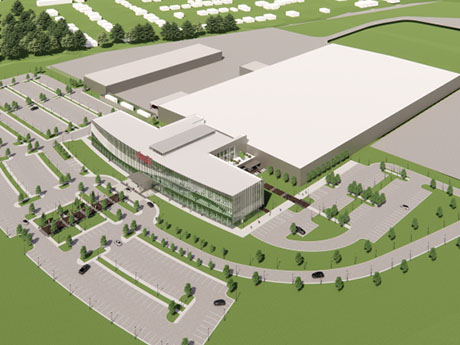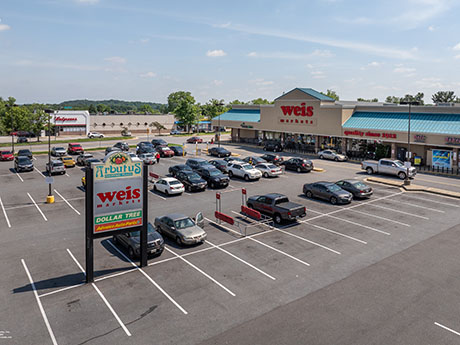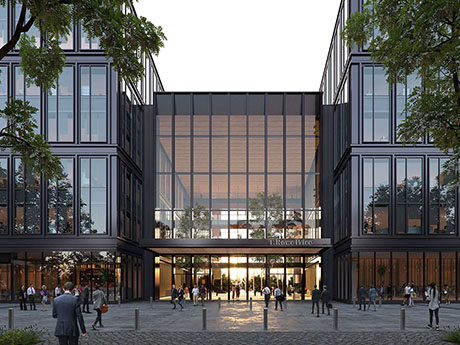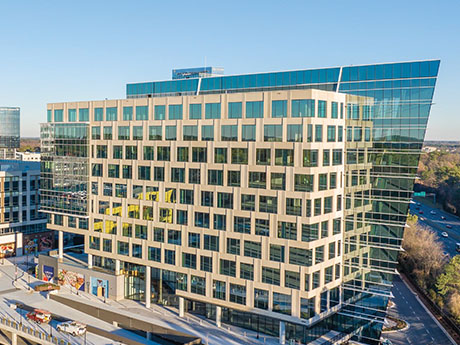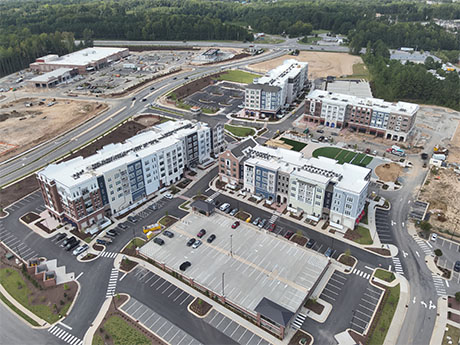The Birmingham industrial market is poised for an increase in absorption as the apex of higher interest rates seem to be settling down, not to mention the post-election certainty that now favors business expansion. Corporate America is waking up and the clouds are clearing. For the past 24 months, the competitive set of investor-controlled warehouse space has been sitting on about 2 million square feet of inventory. About 550,000 square feet of that is still unleased speculative space in three different projects delivered at the back-end of the post-COVID development wave that did see about 700,000 square feet of absorption of new spec space before the music metaphorically stopped. Then came the 2023/2024 wave of the “new spec space,” a byproduct of the mentioned interest rates and COVID over-correction. Several second-generation spaces are now being marketed as companies vacated or downsized for various reasons. For example, discount retailer Dollar General is vacating an entire 307,000-square-foot warehouse. Broader, there have been two major announcements in Central Alabama for the closure of distribution centers, both as a result of retailers’ bankruptcies. JoAnn Fabric’s 700,000-square-foot distribution facility in Opelika at I-85 is now on the market as is the 1.2 million-square-foot former …
Southeast Market Reports
Limited Construction Starts Should Help Birmingham Absorb Available Apartments in 2025
by John Nelson
Southeast Real Estate Business recently caught up with John McCrary, director of investment sales in Berkadia’s Birmingham office, to discuss trends in the local apartment market. McCrary, who specializes in investment sales in Alabama, east Tennessee and southern Mississippi, says that Birmingham’s occupancy will likely take a hit as new deliveries hit the market in the first half of the year, but there’s optimism that renters will be able to absorb those availabilities in short order. “With approximately 800 units expected to be delivered at the beginning of 2025, vacancy rates are likely to rise throughout the year,” says McCrary. “However, the slowdown in construction starts should help absorb existing units and eventually reduce the elevated vacancy rate.” The following is an edited interview: Southeast Real Estate Business: What major local or macro-economic trends are affecting the multifamily market in Birmingham? John McCrary: The interest rate environment is a key factor influencing multifamily dispositions, both in the Southeast and nationwide. Fluctuations in interest rates impact borrowing costs for developers and investors, thereby affecting the supply and demand for multifamily properties. Over the past year, Birmingham has seen strong multifamily demand, but it hasn’t kept pace with the influx of new …
Baltimore’s retail market is alive and well and has experienced something of a boom in retail activity, driven in large part by the thriving retail hubs in the city and in the surrounding suburbs. Demand for space continues to be robust and prospective tenants and investors alike are excited to be part of the Baltimore market. But the reasons why are more nuanced than simply piggybacking off the overall growth that brick-and-mortar retail is seeing across the country. Baltimore is a bargain One of the causes is the terrific value that Charm City offers when comparing prices to the major metropolises of Washington, D.C., to the south and Philadelphia to the north. The Baltimore MSA offers attractive demographics and strong retail fundamentals, making it a prime target for local, regional and national investors. A great example is the sale by KLNB’s Retail Capital Markets team of Arbutus Shopping Center in fall 2024, a 88,000-square-foot, grocery-anchored center that attracted significant demand due to its Baltimore County location, sub-$20 million price point and the broader market’s interest in grocery-anchored retail assets. Due to these robust conditions and factors, among other reasons, owners are hesitant to sell — despite the substantial interest …
Key Bridge Collapse Puts Infrastructure, Baltimore Industrial Market’s Fundamentals in Focus
by John Nelson
A major attraction within the Baltimore industrial real estate market has historically been the Port of Baltimore, as it is the most inland port on the East Coast, ranks in the top 20 nationally for tonnage and top 10 for dry bulk and attracts users and investors for its impressive capabilities. Closing on the end of first-quarter 2025, here are a few noteworthy project and market updates: March 26, 2024: The Key Bridge collapsed due to a physical collision from the container ship Dali. The bridge collapse was a tragic event with six lives lost and shipping (both in and out) being blocked for nearly three months as crews cleared the debris. $2B Key Bridge rebuild: Maryland Gov. Wes Moore unveiled the new design for rebuilding the bridge in February. The bridge is anticipated to deliver by fall 2028 and comes with enhanced capabilities, such as a 45-foot height increase and a 300-foot width increase for the shipping channel when compared with the previous design. Kiewit Infrastructure estimates the overall project will cost $2 billion. Howard Street Tunnel: As part of nearly $500 million directed toward local infrastructure projects, CSX recently kicked off the long-awaited Howard Street Tunnel project being …
The national office market continues to face headwinds in the wake of the COVID-19 pandemic, and Baltimore is no exception. Shifting tenant preferences and the city’s evolving economic landscape have created challenges, with rising vacancy rates in some submarkets. However, recent trends suggest that Baltimore’s office sector is stabilizing, with positive momentum in key areas. Changing office landscape For decades, Baltimore’s office market was defined by two primary submarkets: the traditional central business district (CBD) that is centered around Charles, Saint Paul/Light and Baltimore streets, and the Inner Harbor. The CBD was home to corporate giants such as Alex. Brown & Sons (now part of Deutsche Bank), USF&G (now part of St Paul Insurance), T. Rowe Price and Maryland National Bank (now part of Bank of America). In the 1980s, the Inner Harbor emerged as a national model for waterfront redevelopment, attracting major tenants and commanding some of the city’s highest occupancy rates. The early 2000s saw another shift with the rise of Harbor East and later Harbor Point, both of which drew high-end office tenants and further pulled demand toward the waterfront. More recently, Baltimore Peninsula has emerged as the next major office and mixed-use submarket. Historically, vacancies created …
Raleigh-Durham’s office market entered the year on a positive note as 2024 ended strong. Vacancy was largely flat in the fourth quarter, net absorption neared 300,000 square feet and move-outs were sparse. After years of uncertainty and short-term renewals dominating the landscape, companies are now committing to longer leases. Clarity around business drivers, a growing labor pool and new market entrants are all contributing factors to this decisive turn. Firms are confidently making long-term real estate decisions, bringing lease terms back to the five- to 10-year range. While the vibrancy of the pre-pandemic era has not fully returned, data shows a steady recovery throughout 2024, and 2025 is poised to bring even stronger growth. In 2024, Raleigh-Durham welcomed several notable commitments from companies establishing a foothold in the market, like Jewelers Mutual, JTL and Amgen. Leasing activity stayed strong through the fourth quarter, supporting the net absorption of nearly 160,000 square feet of office space over the course of the year. Rents have seen some downward corrections overall, but well-located, highly amenitized assets have retained rent stability. Recent recommitments from major companies like Nutanix and Hitachi highlight the area’s enduring appeal. Vacancy closed out December at 17.3 percent but was …
The secret is getting out about Apex, a western suburb of Raleigh that also lies 20 miles south of Chapel Hill. In 2018, Realtor.com ranked the city as the No. 1 fastest growing suburb in the United States. This was aided by the master planning of local homebuilder/developer ExperienceOne Homes, which debuted its large-scale Sweetwater residential development in 2016. The allure of Apex didn’t stop there as the local schools within the Wake County Public School System have long been considered top-notch. As more and more families moved to the once-sleepy town, the need for community-serving retail became apparent. And not just any sprawling shopping center would suffice. Retail Strategies of N.C. Inc., on behalf of development partner The Kalikow Group, a multifamily and mixed-use development firm based in Westbury, New York, and the aforementioned ExperienceOne, set out to create a sense of place that would resemble village towns in Northeast states such as Maine and Massachusetts. What all of these hamlets have in common is they are built up over decades around a town center, thus the idea of Sweetwater Town Center was established. East Side The “hard part” was essentially in the rearview mirror as ExperienceOne had already …
For all Top 50 NMHC third-party management firms, the subject of managing rising operating costs is a topic that has come to be front and center in many recent client conversations. “As 2025 budget discussions were taking center stage toward the end of 2024, our clients increasingly highlighted the issues of rising operating costs,” says Lisa Narducci-Nix, director of business development at Drucker + Falk. “This trend”, she adds, “underscores our need for strategic planning and cost management to navigate the continued challenges ahead.” The multifamily sector is facing unprecedented headwinds as operating costs continue to rise, driven by factors ranging from inflation and labor shortages to increased insurance premiums and energy expenses. As a result, multifamily operators are working to find ways to maintain profitability while providing quality living spaces for their residents. “In this challenging environment, it is clear to us that adapting to these rising costs will require a multifaceted approach — one that blends innovation, strategic marketing, operational efficiency and technological adoption,” says Narducci-Nix. Challenges of rising costs Across its 11-state footprint spanning over 42,000 units, Drucker + Falk has seen operating costs for many of its managed assets surge in recent years. The supply chain …
Multifamily Supply Hits Record High in Raleigh-Durham as Development Pipeline Empties
by John Nelson
This year, multifamily housing starts nationally are on pace to hit their lowest levels since 2014, a period marked by the national economy’s gradual recovery from the Great Financial Crisis. Year to date, multifamily deliveries have exceeded starts by 218,500 units, creating a substantial shortfall that signals a significantly reduced apartment supply by 2026. The same trend is taking effect in Raleigh-Durham, where completions exceeded starts by 4,935 units. This is a key consideration for most apartment investment strategies today, explaining why many buyers are willing to accept Year 1 challenges such as softness or negative leverage. As the current supply wave peaks in the Triangle, the future pipeline of multifamily construction is shaping up quite different. Of the identified units that are scheduled for delivery in 2024, nearly 42 percent of units have been delivered as of this writing. Of the approximately 18,600 apartments currently under construction across the Triangle, 13,343 of those are expected to be delivered by the end of third-quarter 2025, with a majority in Central and Southeast Raleigh. However, new activity has slowed significantly — inventory growth by 2027 is projected to drop by more than 85 percent, plummeting to a 3.6 percent rate compared …
In the summer of 2012, fresh out of college and starting my career in retail brokerage at KLNB, a seasoned retail broker-turned-developer warned me to consider other careers. “Retail is dying,” he said. “Why would people go to stores when it’s so easy to order online?” Well, it’s been 12 years since that moment, and I’m still waiting for the retail boogeyman to appear. As I write this, I’m happy to report he hasn’t arrived — and the data suggests he’s nowhere in sight. The Washington, D.C., metropolitan statistical area (MSA) is now in its tightest fundamental position on record due to limited new supply and continued demand from national, regional and franchised concepts. In the Washington, D.C. market, we have the second-lowest retail square footage per capita among major MSAs, with new retail supply representing just 0.4 percent of total inventory. This places the Capital Region in the bottom quartile of retail real estate inventory growth among national MSAs that have more than 100 million square feet of existing inventory. The result? Retail availability in the D.C. metro has decreased to 4.8 percent (compared to the national average of 4.7 percent), down from 5.1 percent year-over-year and 5.3 percent …


